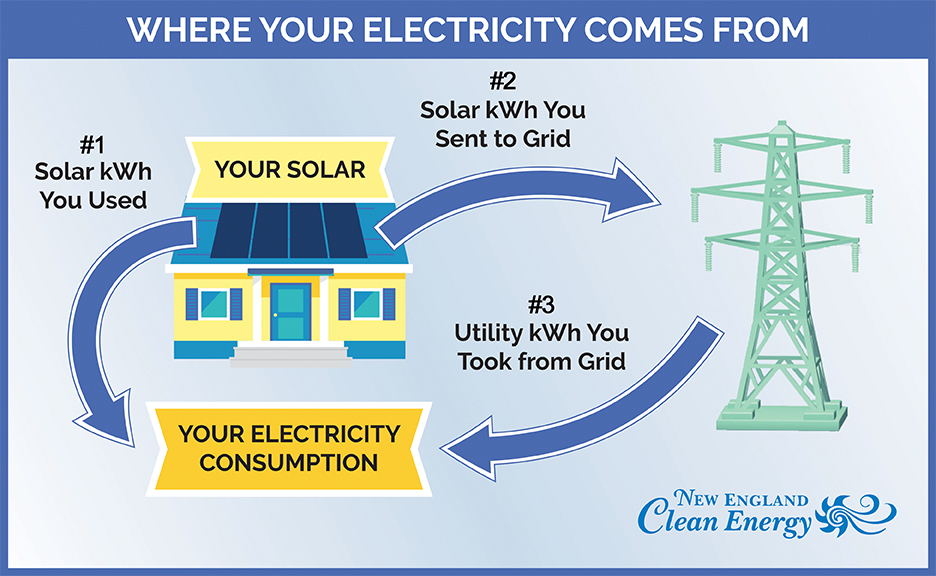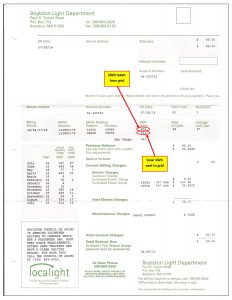If you’re a solar owner, figuring out how much electricity you actually used in a given month is not as easy as it used to be. When all your power came from the utility, a handy graph or chart on the side of your bill probably showed how much electricity you used each of the past 12 months. The kilowatt-hours (kWh) jumped during winter heating or summer pool season. If you made an effort to conserve energy, the kWh went down.
But the numbers in the graph only show what you took from the utility. That’s no longer the same as how much you used in total. What about the solar you made and used right away?
How do you know how much electricity you’re actually using, and how much is from solar vs. fossil fuels?
The answers depend on what state incentive program you participate in, and your utility’s approach to metering and billing. Here are the three most common situations. (Click here for descriptions of the different types of utility meter for solar, if you don’t know which you have.)
Dual Metering (RI REG participants, and MA solar owners starting in 2018)
This is the easiest to explain. You utility meter still works the way it always did. The kWh listed on your bill under “Total Usage” still equals how much you used last month. (All your solar was sent to the grid. It is measured by a completely separate meter and appears on your RI National Grid bill as “Performance Based Incentive Program.”)
Bi-Directional (Customers of some municipal light departments)
At this point, let me explain the three “buckets” of electricity moving in and out of your home:
- Solar kWh you made and used right away, before it could enter the grid
- Solar kWh you made but didn’t use so it was sent into the grid
- “Regular” fossil-fueled kWh you took from the grid when solar wasn’t covering your needs (e.g. at night).
Solar owners with bi-directional metering will see two readings on your monthly bill. On this Boylston Light Department bill (click to enlarge), 978 kWh was taken from the grid (#3 on the illustration) and 231 kWh was sent (#2).
The “net” of those two numbers is 747 kWh taken from the grid. But that’s not what you actually used. We have to factor in the solar electricity you used as soon as it was made (#1).
How do you do that? Let’s use an example with simpler numbers:
a) Look at your solar production meter to see how much solar you made that month. Production meters show a running total, so the math starts here. If your June 30 reading is 10,250 and May 31 was 9,450, you produced 800 kWh in June. (MA solar owners reporting production for SRECs can get the monthly number from the PTS website.)
b) You didn’t necessarily use all 800 kWh. Subtract the solar kWh you sent to the electric company’s grid because you didn’t need it when it was made (#2 on the illustration). Get that number from your bill. Let’s say that was 200 kWh.
c) Don’t forget you probably took some power from the grid. Add the number of “regular” kWh you took from the electric company (#3) as stated on your bill. Let’s say that was 300 kWh.
Your actual electricity consumption for the month of June is 900 kWh:
| Solar produced | Solar sent to grid | Solar taken from grid | Actual usage |
|---|---|---|---|
| 800 kWh | 200 kWh | 300 kWh | 900 kWh |
Net Metering (Customers of the big utilities in MA and NH; and RI if you opted for the REF grant)
If you skipped to here because you have Net Metering, I suggest you go back to the Bi-Directional section because the same basic concept applies. The difference is that your net meter does the math in steps (b) and (c) for you. It combines the solar kWh sent to the grid (#2 in the illustration) with the kWh taken from the grid (#3) and shows you the “net”. This is called “Total Usage” on your bill.
In our example, your net meter would show net usage of 100 kWh (300 kWh taken from grid – 200 sent to grid = 100 kWh). So your monthly consumption is:
| Solar produced | Net of Solar sent to grid combined with Solar taken from grid | Actual usage |
|---|---|---|
| 800 kWh | +100 kWh | 900 kWh |
Net meters can also show a negative if you sent the grid more kWh than you took. Let’s reverse the numbers and say you sent 300 kWh of solar to the grid, and took 200 kWh. Your net is -100 and your monthly consumption is:
| Solar produced | Net of Solar sent to grid combined with Solar taken from grid | Actual usage |
|---|---|---|
| 800 kWh | -100 kWh | 700 kWh |
Use these formulas to calculate your actual electricity usage. Happy consumption monitoring!
If you liked this article, you might also enjoy:
- Different Types of Utility Meters for Solar
- STC vs. PTC: Why Solar Panel Testing Matters
- What’s in a Solar Production Estimate?







No comments yet. You should be kind and add one!
The comments are closed.